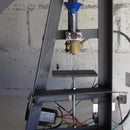Introduction: Upgrade a VU Meter Backlight to Blue Led Using Old CFL Bulb Parts.
While repairing an old Sony TC630 reel-to-reel tape recorder, I noticed one of the glass bulbs for the VU meter back light was broken.
No amount of conductive paint worked as the lead had broken off below the glass surface. The only replacement I could find locally was 3V bulbs for a mini Maglite AA torch, besides being expensive and hard to get, there was no guarantee they would even be bright enough.
The voltage feeding the Vu meter bulbs on the Sony is 1.8V AC and even a sub mini 6v DC glass bulb glowed a dim red.
Recalling a tiny smt joule thief I'd made some years back, I had the idea to light the VU meters with blue leds using a joule thief to bypass the 3.3V forward voltage of the blue leds.
First step was to rectify the AC with 4 diodes per meter and then joule thief the DC to the led.
For this you will need 2 CFL bulbs because there is 1 doughnut ferrite core per CFL.
Step 1: CFL Parts for the Joule Thief.
There's a host of usable parts in the base of a CFL, we need the torroid ferrite core, 1N4007 diodes and some copper wire.
Theres a smaller bobbin ferrite, but I haven't used them in a joule thief, so cant attest to their functionality.
I originally used the 13002S TO92 NPN transistors but found they didn't work at all, probably due to a low gain value, so I replaced them with BC337's.
The other common transistor in CFL's is the SOT32 13003 NPN fast switch which is good for 1.5A continous current.
I had a feeling that if the smaller TO92 ones didn't work, neither would the larger ones.
I counted 8 1N4007 diodes in one CFL.
Each core uses 20 turns of doubled over enameled copper wire roughly 1.2m long.
The circuit diagram was found on BigClives site. He also does Youtube.
Step 2: Opening Up the Sony.
Take off the bottom face plate, slide out the vu meters and label the 4 leads on the back before desoldering.
The backlight leads are the top 2, with the bottom 2 being the input to the needle movement.
I chopped off the tip of the led with a side cutter and sanded the surface to create a more diffused glow.
Step 3: Finishing Up.
The red recording lamps contrast well with the blue glow of the vu meters which are bright enough to read the meter in a darkened room.
I am happy with the end result and it somewhat modernizes the look of an old reel to reel tape deck from 1971.

Participated in the
Recycled Speed Challenge











